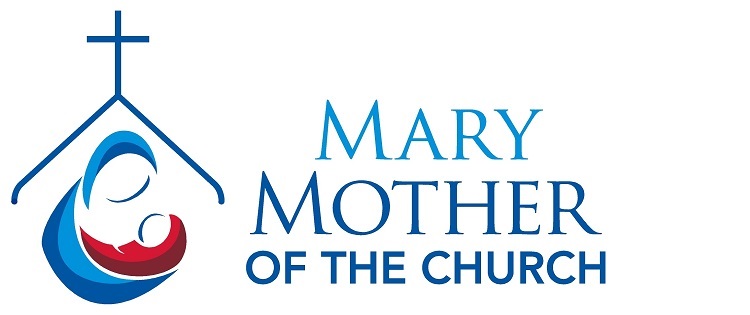
The Symbolic Windows of St. Thomas
More Church

Fr. Del Malin, as assistant pastor at the time of our church's construction, wrote the window descriptions on which this page is based. (The
descriptions were revised in 2002 by Fr. Joseph Rafacz.) He referred to the windows by numbers as shown in the
diagram at right. To jump directly to the information about a particular window, click on any of the numbers in this diagram.
The artist who designed the windows
was Prof.
Anton Wendling of Aachen University in
Aachen, Germany. The craftsman who built the windows was
Erhardt Staettner of the T. C.
Esser Glass Studio in Milwaukee, Wisconsin.
Common Symbols
Although the windows are of a modern style, consistent with the contemporary design of the church,
they contain symbols that trace back to the earliest days of the Christian church.
|

 |
|
The monogram of Jesus Christ,
sometimes called the Chi-Rho, is
formed of the Greek letters Chi (X) and Rho (P), the first two
letters of the word Christ when spelled in Greek (Χριστός).
The Chi-Rho, which traces back to the days of the Emperor
Constantine, represents Christ in many of the windows in our
church. |
|
A Ω |
|
The
Greek letters Alpha and Omega are the first and last letters of the Greek alphabet. They remind of the
eternal nature of God as mentioned Revelation 1:8: "I am the Alpha and the
Omega," says the Lord God, "the one who is and who was and who
is to come, the almighty." |
|
 |
|
A
book most commonly represents the Word of God, the Bible. An
open book (such as window 16A) represents truth or revelation.
In the hands of an Apostle (windows 11B-11E), a book represents
the writings of the New Testament. |
|
 |
|
In several of the windows, folded hands are a symbol of prayer. |
|
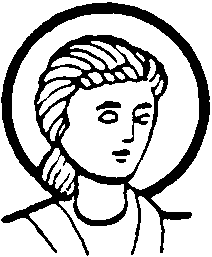 |
|
When
it appears behind a person or object, the nimbus or halo is a symbol of the divine, sacred, or blessed. The visual metaphor
ties grace to light. A glow or light represents grace manifested in or through a divine or blessed person, or transmitted through
or embodied in a sacred object (such as the cross of Christ, the cup of his precious blood, etc.). Beams of light also represent grace in some of the windows. |
|
 |
|
The fleur-de-lis
is a stylized representation of the lily, a flower traditionally symbolic of purity or sinlessness. |
 |
|
The Holy Spirit is
often represented by the figure of a dove. As birds go, doves are peaceful. If you've never watched a dove land, try it the
next chance you get. Doves are big birds with heavy bodies for their size. So when they land, their wings flair broadly, and
there is a sense of "settling" as they land. When you watch a dove land, you understand why the dove is a common symbol of the
Holy Spirit coming over humans. |
 |
|
During early Christianity, Christians were often put to death for practicing their faith, so they worshiped in secret places. A fish painted on the
outside door of a house let other Christians know that they would be safe and welcome inside. So why did they choose a fish for their sign? The Greek word for fish is "ixthus." The first
letter represented the word Jesus. The second letter represented the word Christ, the next two, God Son, and the final letter represented the word Savior. This adds up to “Jesus Christ, Son
of God, Savior.”
In some settings (such as window 4B), the fish represents us, the people of Christ, called to be like Christ. |
Window 1: Eucharist
 |
|
A |
|
The pelican was a Christian sign in
the first centuries of the church. It symbolizes Christ in the
Eucharist who feeds us with the Sacrament of his body and blood.
The pelican has a long beak and
a sack where it stores small fish to feed to its young. In the
process of feeding, the bird appears to open its own breast with
its bill. The reddish tinge of its plumage and the redness of
its beak prompted the legend that it drew its own blood to feed
its young, as Christ shed his blood for our salvation. |
|
 |
|
B |
|
Doves
looking at the host symbolize the faithful who look to the Eucharist for spiritual
food. The three rays of light symbolize the grace that comes
from the Holy Trinity to us through the Eucharist.
Another possible interpretation of this window is that two doves, regarded in Jesus' time as a minimal sacrifice, look up to the
greater sacrifice made by Christ himself. |
 |
|
C |
|
The
Agnus Dei (Latin for "Lamb of God") is a lamb who symbolizes Christ,
the Lamb of God. "[John] saw Jesus walking toward him and declared,
'Here is the Lamb of God who takes away the sin of the world!'" The banner of Easter victory
over sin and death features a
red cross on a white pennant, similar to the St. George's Cross. The blood flowing into the chalice
is the precious blood He shed for our salvation. |
Window 2: Eucharist
 |
|
A |
|
The stag drinks flowing water,
recalling Psalm 42: "As a deer longs for flowing streams, so my
soul longs for you, O God." |
 |
|
B |
|
The
Lamb of God, who takes away the sins of the world, is depicted
as pierced by a sword, symbolizing the sacrificial death of Christ.
The Lamb of God's blood flows into the chalice, becoming the
Precious Blood that we consume at the Holy Eucharist. |
 |
|
C |
|
The
loaves and fish remind us of the miracle of the multiplication
of the bread and fish. "After taking the five loaves and
the two fish, He looked up to Heaven, and blessed and broke
them, and gave them to the disciples to set before the crowd.
And all ate and were filled. What was left over was gathered up,
twelve baskets of broken pieces." (Matthew 14:13-21; Mark
6:34-44; Luke 9:11-17; John 6:1-15) As those 5,000 were
hungry, so the people of God still hunger for the spiritual
nourishment that is the Holy Eucharist. |
Window 3: Eucharist
 |
|
A |
|
The stalks of wheat imposed on a cross symbolize the bread that Christ blessed and broke at the
Last Supper. We recall his words at every Mass: "Before he was given up to death, a death he freely accepted, he took
bread and gave you thanks. He broke the bread, gave it to his disciples, and said: 'Take
this, all of you, and eat it, for this is my body which will be given up for you.'"
During Mass, at the beginning of the Liturgy of the Eucharist, the priest says these words: "Blessed are you, Lord God of all
creation. Through your goodness we have this bread to offer, which earth has given and human hands have made. If will become for us the bread of life." |
 |
|
B |
|
The bunches of grapes imposed on a cross symbolize the wine that
Christ presented with these words: "When supper was ended, he took the cup. Again he gave you thanks and praise, gave the
cup to his disciples and said: 'Take this, all of you, and drink from it. This is the cup of my blood, the blood of the
new and everlasting covenant. It will be shed for you and for all so that sins may be forgiven. Do this in memory of me.'"
During Mass, at the beginning of the Liturgy of the Eucharist, the priest says these words: "Blessed are you, Lord God of all
creation. Through your goodness we have this wine to offer, fruit of the vine and work of human hands. It will become our spiritual drink." |
 |
|
C |
|
The monstrance is used to enthrone the consecrated host at
Eucharistic Adoration. When we place ourselves prayerfully in His presence we receive His grace, symbolized by the rays of
light.
The word monstrance comes from the Latin word monstrare, meaning "to show." |
Window 4: Eucharist
 |
|
A |
|
Symbols in this window are the cross, a bowl of bread, and a fish.
Right along with the most essential of foods, for our sustenance, is the sacrifice of Jesus Christ himself. |
 |
|
B |
|
The two fish emerging from the water represent Christian people
who, after baptism, yearn to approach Christ in Holy Communion. |
 |
|
C |
|
The host and chalice are the Most Holy Body and Blood of Christ which we receive as Eucharist.
During the Mass, we kneel briefly after the Lamb of God, as the priest holds high the host and chalice. His words quote John the Baptist at the River Jordan:
"Behold the Lamb of God who takes away the sin of the world." (John 1:29). We respond humbly with a paraphrase of words once uttered by a Roman centurion:
"Lord, I am not worthy that you should enter under my roof, but only say the word, and my soul shall be healed" (Matthew 8:8). |
Window 5: St. Joseph
 |
|
A |
|
Joseph was a carpenter whose tools included a plane, square, hammer, and nails. St. Joseph the Worker is the primary patron saint of the Diocese of La Crosse. |
 |
|
B |
|
Saint Joseph is a patron of the universal church. The church of Christ is
represented here and in Window 16E as a boat, making its way through sometimes stormy or unsettling seas, but always under
the protection of Christ, represented by the Chi-Rho monogram atop the sail. The illustration in this window is of a fishing boat sailing as if towards the viewer, with brown hull and blue sail. |
 |
|
C |
|
The fleur-de-lis, a stylized depiction of the lily, recalls the purity of Saint Joseph. |
Window 6: From Death to Life
 |
|
A |
|
The laurel wreath, used by the Greeks and Romans as a symbol of victory, is for us a symbol of
Christ's ultimate victory over sin. The stars remind us that this victory of life over
death will be manifest not in this world but the next. The crown reminds us that by conquering sin and death, Christ is the King
of kings: "...the Lamb will conquer them, for he is Lord of lords and King of kings..." (Rev 17:14). |
 |
|
B |
|
Folded hands touched by flame represent the souls in Purgatory
for whom we pray: "Eternal rest grant unto them, O Lord, and let perpetual light shine upon
them." Beams of light symbolize the grace that comes to them through our prayers of intercession. |
 |
|
C |
|
A red band separates this life from the next. Below it, the
hour glass, nearly empty, reminds us of approaching death. The dove represents the soul released from the body after death, rising
to the eternal reward. In the dome of the sky, representing the afterlife, a tower symbolizes God our Refuge. |
Window 7: Blessed Virgin Mary
 |
|
A |
|
The crown is symbolic of Mary's role as the mother of a King. The letters A and M represent Ave
Maria (Hail Mary), a prayer we pray often: Hail, Mary, full of grace; the Lord is with thee. Blessed art
thou among women and blessed is the fruit of thy womb, Jesus. Holy Mary, Mother of God, pray for us sinners, now and at the hour of our death. Amen. |
 |
|
B |
|
The letter M superimposed on the cross symbolizes Mary's relationship
with Christ; the mother who bore him, raised him, stood nearby His cross, and whose heart was "pierced by the sword" as she cradled his
dead body. She challenged him about staying behind at the temple; perhaps his reply, confirming who he was, gave her
the assurance to tell the stewards at Cana, over his objection, to "do whatever he tells you." The Gospels do not record the risen Christ appearing to his
mother, but as the faithful son he would have done so, of course. What a moment that must have been! |
 |
|
C |
|
The dove smbolizes the manner in which Mary's son was conceived: "Mary said
to the angel, 'How can this be, since I am a virgin?' The angel sid to her, 'The Holy Spirit will come upon you, and the power
of the Most High will overshadow you; therefore the child to be born will be holy; he will be called the Son of God.'" (Luke 1:34-35).
Mary's purity is represented by the fleur-de-lis or lily. The twelve stars are her crown of glory: "A woman clothed with the sun, with the moon
under her feet, and on her head a crown of twelve stars" (Revelation 12:1).
The red, white, and blue shield represents Mary's role as patron of the United States. |
Window 8: The Holy Trinity
|
 |
|
A |
|
The Holy Trinity are represented by the crown of the Father, the cross of Christ, the dove of the Holy Spirit.
Fifteen roses represent the 15 mysteries of the complete rosary: White for the Joyful Mysteries of Christ's birth, red for the Sorrowful Mysteries of his crucifixion, and gold for the
Glorious Mysteries of his resurrection. In 2002, Pope John Paul II added a fourth setting, the Luminous Mysteries, evoking Christ's baptism, his first miracle at Cana,
His proclamation of the coming of the Kingdom of God, the Transfiguration, and His institution of the Eucharist. |
 |
|
B |
|
Christ is represented in the forms of his cross, the chalice of
his precious blood which was spilled for us, and an anchor, symbolizing that despite all storms, Christ is our sure hope of salvation. |
 |
|
C |
|
The "all-seeing eye" symbol speaks of the Father's omnipotence over all creation. The
equilateral triangle suggests three co-equal persons in one God. The trefoil of three circles means three persons having no
beginning and no end. Folded hands receiving beams of light represent grace coming to those who pray. |
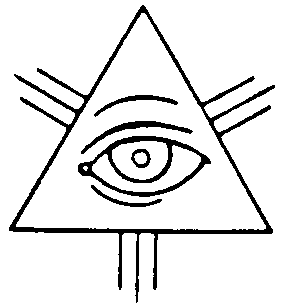 |
Window 9: Priesthood and the Sacrament of Holy Orders
 |
|
A |
|
The green cross represents the Irish ancestry of Bishop John Patrick Treacy, the Bishop of La Crosse
at the time that the church was built. The shepherd's crook and hat symbolize the bishop's appointment to shepherd God's people. |
 |
|
B |
|
The Chi-Rho Cross and lighted lamp symbolize the light of Christ which the priest
is charged with bringing to the people. Light from the lamp is a metaphor for the Gospel truth, as further symbolized by the open
book. "I am the Way, the Truth, and the Life." (John 14:6) |
 |
|
C |
|
The words "Thou Art a Priest Forever" remind the priest of his vocation to imitate Christ.
A loaf of bread and a cup of wine from the Old Testament Melchizedech (Genesis 14:18) foreshadows the Holy Eucharist. Psalm 110:4 declares: "The Lord has sworn
and will not waver: 'Like Melchizedek you are a priest forever.'" In Hebrews 5:8-10, Jesus is described as the new and perfect
high priest: "Son though he was, he learned obedience from what he suffered; and when he was made perfect, he became the source
of eternal salvation for all who obey him, declared by God high priest according to the order of Melchizedek." |
 |
|
D |
|
During the Mass, at the Doxology, the priest raises the cup and host and sings, "Through him, with
him, and in him, in the unity of the Holy Spirit, all glory and honor is yours, almighty Father, for ever and ever." The people respond with the Great Amen. |
 |
|
E |
|
The Bishop is represented by a slate, Episcopal ring. The chalice is touched by the priest
being ordained. The Chi-Rho Cross reminds the priest that he is to imitate Christ. The Book of the Gospels represents the
priest's charge to preach the Word of God. |
Window 10: Benedictine Sisters
At the time of the
construction of St. Thomas More Church, the
Benedictine Sisters were the first teachers at St. Thomas More School.
 |
|
A |
|
The three circles and the Chi-Rho symbolize the union of the Benedictine with Christ through the vows of perpetual Poverty, Chastity, and
Obedience. The fleur-de-lis represent other vows of the Benedictine, Hospitality and Stability. |
 |
|
B |
|
"Ora et Labora" means "Pray and Work,"
the motto of the Order of St. Benedict. The book represents the
Rule of St. Benedict. |
 |
|
C |
|
The Ten Commandments are basis for the Benedictine rule of
life for the love of Christ symbolized by the Chi-Rho. The Book of the Seven Seals (Revelation 5) appears, representing that a Benedictine is
inscribed in the Book of Life by keeping the Ten Commandments and the Rule of St. Benedict. |
 |
|
D |
|
The medal of St. Benedict is a cross. Inscribed on vertical are the letters CSSML, which abbreviate
the Latin prayer, "Cruce Sacra Sit Mihi Lux" which means "May the Cross be the Light for me." On the horizontal is NDSMD,
which stands for the Latin prayer "Non Draco Sit Mihi Dux" meaning "May the devil not be my leader." The four large letters
in the arms of the cross spell CPSB for "Crux Sancti Patris
Benedicti," the Cross of Holy Father Benedict. "Pax", Latin for peace, has been a Benedictine motto for centuries. |
 |
|
E |
|
The yoke and Chi-Rho symbolize the work of Christ to which Benedictines devote themselves. The thorns and the lily remind
us of the famous temptation of St. Benedict of Nursia to return to the
secular life. As if to tear the temptation from himself, he threw himself on a thorn bush. |
Window 11: The Four Evangelists and Saints Peter and Paul
It seems the designer may have intended this window to be perceived from bottom to top.
 |
|
A |
|
Saints Peter and Paul: Peter, first head of the Church and first Pope,
is given the keys to the kingdom. Paul is represented by the sword, symbolizing both his feisty apostolate and his martyrdom. |
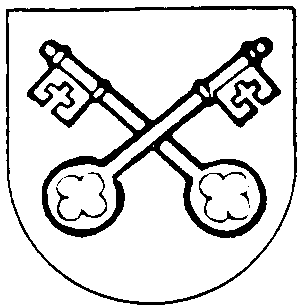 |
 |
|
B |
|
The four evangelists are the writers of the four gospels. They are
represented by the four winged creatures that the prophet Ezechiel beheld in a vision (Ezechiel 1:10-11): "As for the
appearance of their faces: they had the face of a human being, the face of a lion, the face of an ox, and the face of an
eagle."
John's gospel emphasizes the work of the Holy Spirit and is written in a soaring spirit, so an eagle represents John. |
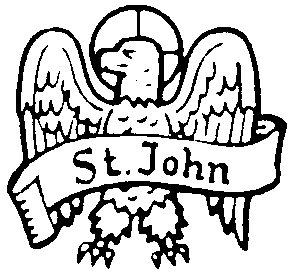 |
 |
|
C |
|
Luke begins his gospel with the story of the prophesy and birth of
John the Baptist. His parents were Elizabeth (cousin of Mary) and Zechariah, a priest. Because oxen were often offered for sacrifice
by priests, an ox represents Luke. |
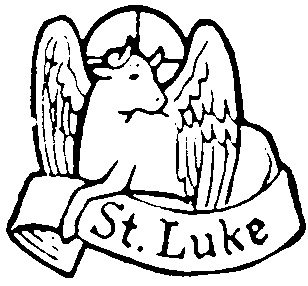 |
 |
|
D |
|
A winged lion is Mark's symbol. The lion derives from Mark's description of John the Baptist as a "voice of one crying
out in the desert" (Mark 1:3), which artists compared to a roaring lion. |
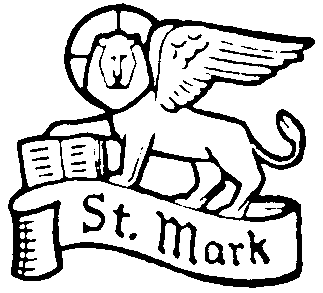 |
 |
|
E |
|
Matthew begins his gospel by tracing the human lineage from
Abraham to David to Jesus. Since Matthew begins with human beings and the holy humanity of Jesus, Matthew's symbol bears a human face. |
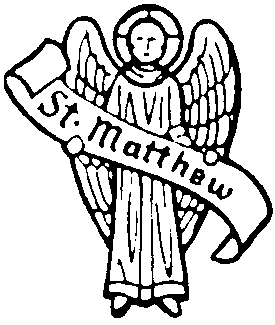 |
Window 12: The Church Year
It seems the designer may have intended this window to be perceived from bottom to top.
 |
|
A |
|
Pentecost Sunday recalls the moment when the Holy Spirit came
over the apostles. Here the graces of the Spirit are represented as rays of light. The tongues of flame that appeared over the
apostles are depicted here as oil lamps. |
 |
|
B |
|
Easter is represented by the triumphant Lamb of God (Christ), who carries the banner of the
Resurrection. He stands atop the Book of the Seven Seals (Revelation 5), indicating that Christ will return in judgment. |
 |
|
C |
|
Lent is represented as an open book, a symbol of learning. The three-pronged lash recalls the passion
of the Christ and our call to self-denial and penitence. The fish is symbol of the fasting and abstinence of the Lenten season. |
 |
|
D |
|
Christmas is represented by the Christ (in the form of the chi-rho cross with nimbus) in a manger. |
 |
|
E |
|
Advent is depicted through the Greek "Phos Zoe" cross, formed in
the vertical letters Phi Omega Sigma (spelling "phos," the Greek for "light") and the
horizontal Zeta Omega Eta (spelling "zoe," which means "life"). Thus this form of the cross speaks of the Christ of Advent who
comes as a light in darkness, and upon him is our hope for life eternal. The oil lamps signify that Advent is about awaiting his arrival. |
Window 13: Music
 |
|
A |
|
The pipe organ is the traditional instrument of formal worship.
St. Cecilia, the patron of musicians, is sometimes portrayed anachronistically by artists as playing a miniature organ called a portative. |
 |
|
B |
|
The lyre, or shepherd's harp, was the instrument David played while composing the Psalms. Psalm 101: "I sing of love and justice; to you, Lord, I sing praise." |
 |
|
C |
|
The trumpet is a symbol of the Last Judgment, the resurrection, and
the call to worship. Trumpets call to mind the story of Joshua and the battle of Jericho (Joshua 6) and of Gideon against the Midianites (Judges 7). |
Window 14: Music
 |
|
A |
|
Birds and chant music remind us that worship is to be joyful and reflective. |
 |
|
B |
|
The harp has been used to represent the Psalms and all music and instruments that
are used to praise and glorify God. |
 |
|
C |
|
By tradition, bells call us to worship. They remind us to give
worship a higher priority than our secular, everyday business. |
Window 15: The Sacraments
In the Catholic faith there are seven sacraments; five are depicted in this window. Other windows portray the other two sacraments, Eucharist and Holy
Orders.
 |
|
A |
|
In the Sacrament of
Matrimony, two are united under the protection and grace of the Christ. |
 |
|
B |
|
Anointing of the
Sick is a sacrament of for any Catholic facing physical or mental illness, poor health, or
an imminent death. Here the urn is symbol of the chrism oil used for anointing, and the lamp
suggests a vigil. This sacrament gives grace and a gift of the Holy Spirit that renews confidence and
faith in God and strengthens against temptations to lapse into discouragement and anguish. It thus leads to spiritual healing with forgiveness of sins.
See James 5:14-15: "Is any among you sick? Let him call for the elders of the church,
and let them pray over him, anointing him with oil in the name of the Lord; and the prayer of faith
will save the sick man, and the Lord will raise him up; and if he has committed sins, he will be forgiven." (Also see Matthew 10:8, Luke 10:8-9 and Mark 6:13.) |
 |
|
C |
|
Reconciliation
is a sacrament of healing, repairing the relationship between a sinner and the communion of the church (and thereby God) through the rite of confession, absolution, and
penance. The key and stole recall Christ's solemn words to Simon Peter: "I will give you the keys of the kingdom of heaven, and
whatever you bind on earth shall be bound in heaven, and whatever you loose on earth shall be loosed in heaven." |
 |
|
D |
|
Confirmation
is a sacrament of initiation into a mature, adult participation in the church. The bishop imposes his hands as he says "receive the
Holy Spirit," symbolized in this window by a dove. The helmet, shield, sword, and chi-rho are symbols of the notion of the
confirmed person as becoming a "soldier of Christ." |
 |
|
E |
|
Baptism is a sacrament of initiation into membership in the church. It is symbolized here by the font of water. Christ
commanded his disciples (Matthew 28:19) to baptize and declared the absolute necessity of baptism (John 3): "Unless a man be born
again of water and the Holy Ghost, he can not enter into the Kingdom of God." |
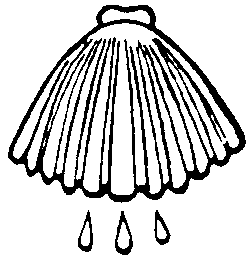
|
Window 16: The Church
 |
|
A |
|
A (Alpha) and Ω (Omega) are the first and last letters of the Greek alphabet,
symbolic of the eternal nature of the church founded by Christ, the true Alpha and Omega. The book and lamp signify that the church is to bring God's
grace and eternal truth to the world by preaching the Gospel. |
 |
|
B |
|
The pillar or rock (Peter) represents the foundation of the church, and the four
streams of water represent its attributes: One, Holy, Catholic, and Apostolic. |
 |
|
C |
|
The four smaller crosses represent the four gospels. The calling of the church is to bring the Good News into the world. |
 |
|
D |
|
The large cross is that of Christ, flanked by the crosses of the two
thieves who were executed with him. Folded hands represent prayer. |
 |
|
E |
|
At the church's founding, Peter (the fisherman, represented by a
boat) is its leader. The church is energized by the Holy Spirit, represented here as a dove, the wind in our sails. |
Window 17: St. Thomas More, Patron of this Church Building
 |
|
A |
|
The Papal Crown is
symbol of More's fidelity to the apostolic lineage, whose authority was inconvenient to King Henry VIII. In 1527, Henry instructed
Thomas Cardinal Wolsey to petition Pope Clement VII for an annulment of his marriage to Catherine of Aragon. The pope
steadfastly refused such an annulment. Henry reacted by forcing Wolsey to resign as Lord Chancellor and by appointing Thomas
More in his place in October 1529. (More accepted reluctantly, as he was the first layman to hold the post.) Henry then began
to embrace the belief that the Pope was only the Bishop of Rome and therefore had no authority over the Christian Church as a
whole. The stage was set for More to be compelled to make a terrible yet glorious choice. |
 |
|
B |
|
The laurel wreath (as in window 6A) represents the victory of the martyr over death. The sword symbolizes the manner of
More's execution; on 6 July 1535, he was beheaded at the Tower of London. |
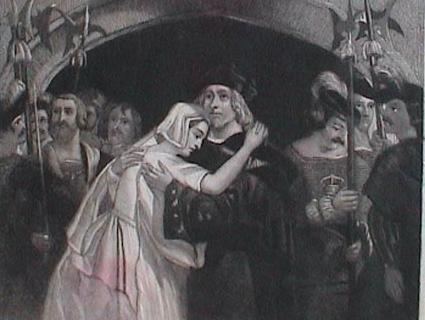 |
 |
|
C |
|
The sword represents the manner of More's death. The Cross is symbolic of his faith and the reason for his martyrdom. The
inverted crown suggests that in ordering the death of Thomas More, King Henry VIII perverted any and all of his claims to ecclesial leadership. |
 |
|
D |
|
More's first wife died in 1511. More remarried almost immediately so that his
children would have a mother. His second wife, Alice Middleton, was a widow seven years his senior. |
 |
|
E |
|
The intertwined rings and water jars (as at Cana) are symbols of marriage. In
1505, aged twenty-seven, Thomas More married his first wife, Jane Colt. The marriage was happy and they had four children;
Margaret (known as Meg), Elizabeth, Cicely, and John. Unusual for the time, he put as much effort into educating his daughters as he did his
son, declaring that women were just as intelligent as men. |
Window 18: St. Thomas More, Patron of this Church Building
 |
|
A |
|
The Tower of London was a royal prison in
which More spent over a year because he refused to take an oath of allegiance to an Act of Parliament called the
Law of Succession. More acknowledged Parliament's authority to establish Anne Boleyn as Queen, but could not accept language in the law's preamble which
denied the authority of the pope. In July 1535 he was tried for high treason, convicted on the basis of perjured testimony, and sentenced to death.
The nimbus in the sky over the tower reminds us that even in that forbidding place, More's soul was under God's protection. |
 |
|
B |
|
In 1515, Thomas More wrote his most famous and controversial work, Utopia, a novel whose primary message is the need for order and
discipline rather than liberty. The society described is almost totalitarian, and very far removed from present day ideals of
freedom. Later, when he became Lord Chancellor, More vigorously opposed and suppressed the rising tide of papal separatism.
For More, heresy was a disease, a threat to the peace and unity of both church and society. The cap above the book is a style then popular among scholars. |
 |
 |
|
C |
|
Pictured here is the necklace of the Lord Chancellor, an external sign of the office More held from 1529 to 1532. The pendant is a
Tudor Rose, representing the House of Tudor, of which Henry VIII was a member. Inside the necklace is a cross symbolizing
More's unyielding adherence to his faith.
In the end, More regarded loyalty to Christ and his Church, seated in the authority of the pope, above his responsibilities as Chancellor, even above his own life. |
 |
|
D |
|
The scepter, scroll, and official seal are symbols of More's office as Lord Chancellor of England. That office entailed being
the King's chaplain and also became known as the "Keeper of the King's Conscience." In 1530 More refused to sign a
letter by the leading English churchmen and aristocrats asking the Pope to annul Henry's marriage to Catherine. In 1531 More attempted to resign after
being pressured to take an oath declaring the king the supreme head of the English church "as far the law of Christ allows." |
 |
|
E |
|
In the scales of
justice (doubly symbolic because More was trained in law), the authority of the King (represented here by a crown)
is outweighed for More by the authority of the faith. More repeatedly denied any malice toward the king. Just before the fatal blow he addressed onlookers, asking them
to pray for the king and proclaiming, "I die the King’s good servant, but God’s first." |
Sources
Knapp, Sr. M. A. Justina, OSB. Christian Symbols and How to Use Them. Milwaukee: The Bruce Company, 1935.
Rest, Friedrich. Our Christian Symbols. Philadelphia: The Christian Education P, 1954.
Van Treeck, Carl, and Aloysius Croft. Symbols in the Church. Milwaukee: The Bruce Company, 1960.
West, Edward N. Outward Signs: the Language of Christian Symbolism. New York: Walker and Company, 1989.
Our thanks to Tom Thibodeau and Therese van Oss for their help in the research.
Updated 28 February 2022
![]()
![]()
![]()
![]()

![]()















































































